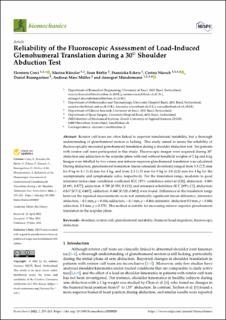Please use this identifier to cite or link to this item:
https://doi.org/10.21256/zhaw-27493Full metadata record
| DC Field | Value | Language |
|---|---|---|
| dc.contributor.author | Croci, Eleonora | - |
| dc.contributor.author | Künzler, Marina | - |
| dc.contributor.author | Börlin, Sean | - |
| dc.contributor.author | Eckers, Franziska | - |
| dc.contributor.author | Nüesch, Corina | - |
| dc.contributor.author | Baumgartner, Daniel | - |
| dc.contributor.author | Müller, Andreas Marc | - |
| dc.contributor.author | Mündermann, Annegret | - |
| dc.date.accessioned | 2023-03-28T14:59:29Z | - |
| dc.date.available | 2023-03-28T14:59:29Z | - |
| dc.date.issued | 2022-05-19 | - |
| dc.identifier.issn | 2673-7078 | de_CH |
| dc.identifier.uri | https://digitalcollection.zhaw.ch/handle/11475/27493 | - |
| dc.description.abstract | Rotator cuff tears are often linked to superior translational instability, but a thorough understanding of glenohumeral motion is lacking. This study aimed to assess the reliability of fluoroscopically measured glenohumeral translation during a shoulder abduction test. Ten patients with rotator cuff tears participated in this study. Fluoroscopic images were acquired during 30° abduction and adduction in the scapular plane with and without handheld weights of 2 kg and 4 kg. Images were labelled by two raters, and inferior-superior glenohumeral translation was calculated. During abduction, glenohumeral translation (mean (standard deviation)) ranged from 3.3 (2.2) mm for 0 kg to 4.1 (1.8) mm for 4 kg, and from 2.3 (1.5) mm for 0 kg to 3.8 (2.2) mm for 4 kg for the asymptomatic and symptomatic sides, respectively. For the translation range, moderate to good interrater (intra-class correlation coefficient ICC [95% confidence interval (CI)]; abduction: 0.803 [0.691; 0.877]; adduction: 0.705 [0.551; 0.813]) and intrarater reliabilities (ICC [95% CI]; abduction: 0.817 [0.712; 0.887]; adduction: 0.688 [0.529; 0.801]) were found. Differences in the translation range between the repeated measurements were not statistically significant (mean difference, interrater: abduction, -0.1 mm, p = 0.686; adduction, -0.1 mm, p = 0.466; intrarater: abduction 0.0 mm, p = 0.888; adduction, 0.2 mm, p = 0.275). This method is suitable for measuring inferior-superior glenohumeral translation in the scapular plane. | de_CH |
| dc.language.iso | en | de_CH |
| dc.publisher | MDPI | de_CH |
| dc.relation.ispartof | Biomechanics | de_CH |
| dc.rights | http://creativecommons.org/licenses/by/4.0/ | de_CH |
| dc.subject | Abduction | de_CH |
| dc.subject | Fluoroscopy | de_CH |
| dc.subject | Glenohumeral instability | de_CH |
| dc.subject | Humeral head migration | de_CH |
| dc.subject | Rotator cuff | de_CH |
| dc.subject | Shoulder | de_CH |
| dc.subject.ddc | 617.5: Orthopädische Chirurgie | de_CH |
| dc.title | Reliability of the fluoroscopic assessment of load-induced glenohumeral translation during a 30° shoulder abduction test | de_CH |
| dc.type | Beitrag in wissenschaftlicher Zeitschrift | de_CH |
| dcterms.type | Text | de_CH |
| zhaw.departement | School of Engineering | de_CH |
| zhaw.organisationalunit | Institut für Mechanische Systeme (IMES) | de_CH |
| dc.identifier.doi | 10.3390/biomechanics2020020 | de_CH |
| dc.identifier.doi | 10.21256/zhaw-27493 | - |
| dc.identifier.pmid | 35677586 | de_CH |
| zhaw.funding.eu | No | de_CH |
| zhaw.issue | 2 | de_CH |
| zhaw.originated.zhaw | Yes | de_CH |
| zhaw.pages.end | 263 | de_CH |
| zhaw.pages.start | 255 | de_CH |
| zhaw.publication.status | publishedVersion | de_CH |
| zhaw.volume | 2 | de_CH |
| zhaw.publication.review | Peer review (Publikation) | de_CH |
| zhaw.funding.snf | 189082 | de_CH |
| zhaw.webfeed | BME Biomechanical Engineering - Surgical Technologies | de_CH |
| zhaw.funding.zhaw | Einfluss der zusätzlichen Gewichtsbelastung auf die belastungsinduzierten Veränderungen der glenohumeralen Translation bei Patienten mit Rotatorenmanschettenriss - ein translatorischer Ansatz | de_CH |
| zhaw.author.additional | No | de_CH |
| zhaw.display.portrait | Yes | de_CH |
| Appears in collections: | Publikationen School of Engineering | |
Files in This Item:
| File | Description | Size | Format | |
|---|---|---|---|---|
| 2022_Croci-etal_Fluoroscopic-assessment-reliability-glenohumeral-translation.pdf | 1.89 MB | Adobe PDF |  View/Open |
Show simple item record
Croci, E., Künzler, M., Börlin, S., Eckers, F., Nüesch, C., Baumgartner, D., Müller, A. M., & Mündermann, A. (2022). Reliability of the fluoroscopic assessment of load-induced glenohumeral translation during a 30° shoulder abduction test. Biomechanics, 2(2), 255–263. https://doi.org/10.3390/biomechanics2020020
Croci, E. et al. (2022) ‘Reliability of the fluoroscopic assessment of load-induced glenohumeral translation during a 30° shoulder abduction test’, Biomechanics, 2(2), pp. 255–263. Available at: https://doi.org/10.3390/biomechanics2020020.
E. Croci et al., “Reliability of the fluoroscopic assessment of load-induced glenohumeral translation during a 30° shoulder abduction test,” Biomechanics, vol. 2, no. 2, pp. 255–263, May 2022, doi: 10.3390/biomechanics2020020.
CROCI, Eleonora, Marina KÜNZLER, Sean BÖRLIN, Franziska ECKERS, Corina NÜESCH, Daniel BAUMGARTNER, Andreas Marc MÜLLER und Annegret MÜNDERMANN, 2022. Reliability of the fluoroscopic assessment of load-induced glenohumeral translation during a 30° shoulder abduction test. Biomechanics. 19 Mai 2022. Bd. 2, Nr. 2, S. 255–263. DOI 10.3390/biomechanics2020020
Croci, Eleonora, Marina Künzler, Sean Börlin, Franziska Eckers, Corina Nüesch, Daniel Baumgartner, Andreas Marc Müller, and Annegret Mündermann. 2022. “Reliability of the Fluoroscopic Assessment of Load-Induced Glenohumeral Translation during a 30° Shoulder Abduction Test.” Biomechanics 2 (2): 255–63. https://doi.org/10.3390/biomechanics2020020.
Croci, Eleonora, et al. “Reliability of the Fluoroscopic Assessment of Load-Induced Glenohumeral Translation during a 30° Shoulder Abduction Test.” Biomechanics, vol. 2, no. 2, May 2022, pp. 255–63, https://doi.org/10.3390/biomechanics2020020.
Items in DSpace are protected by copyright, with all rights reserved, unless otherwise indicated.